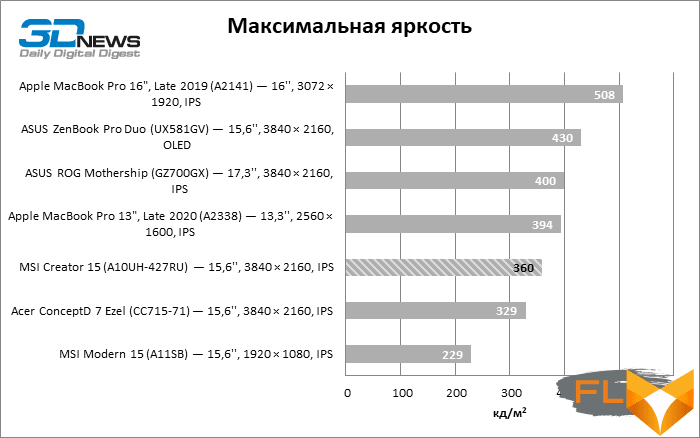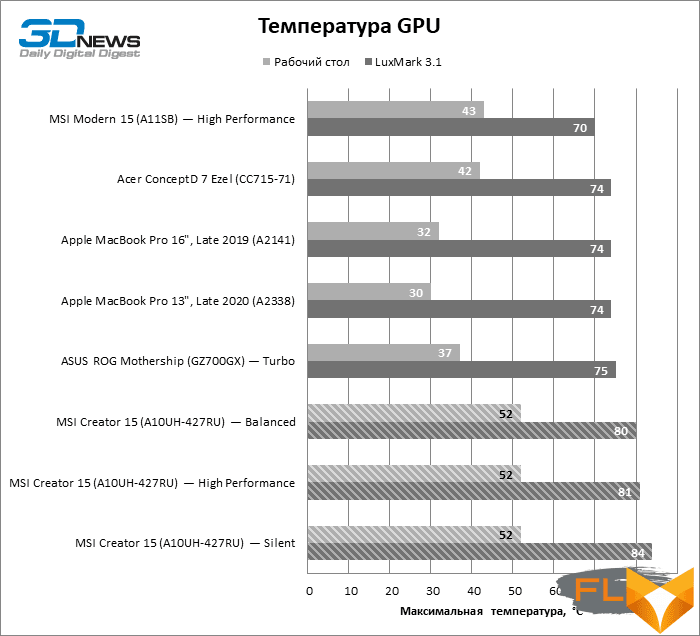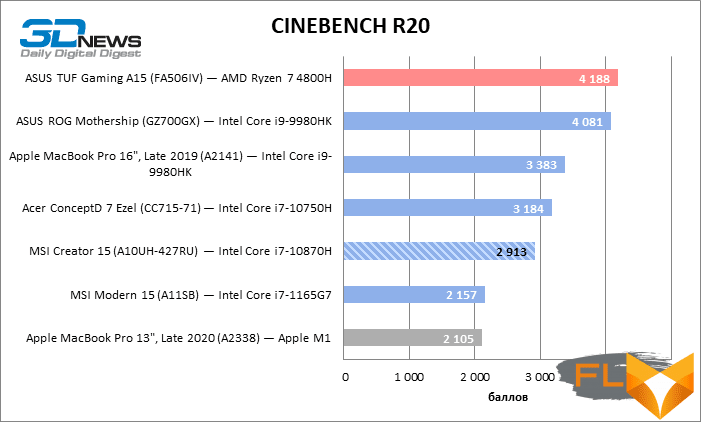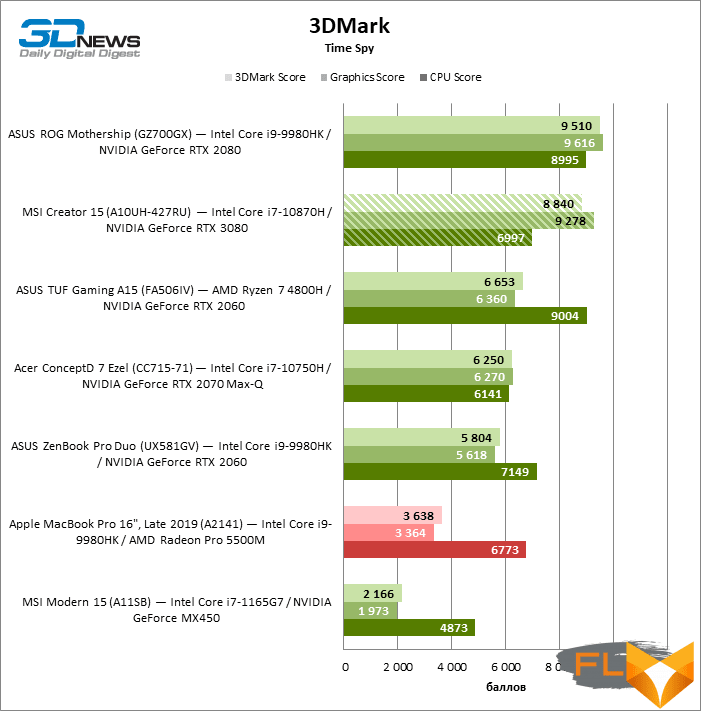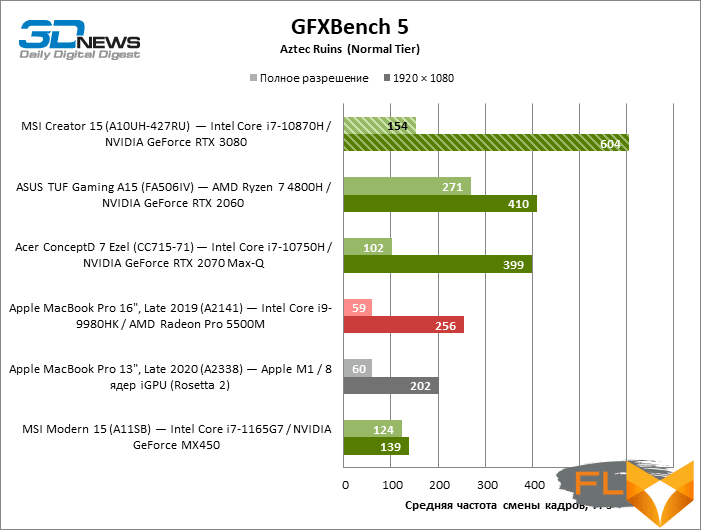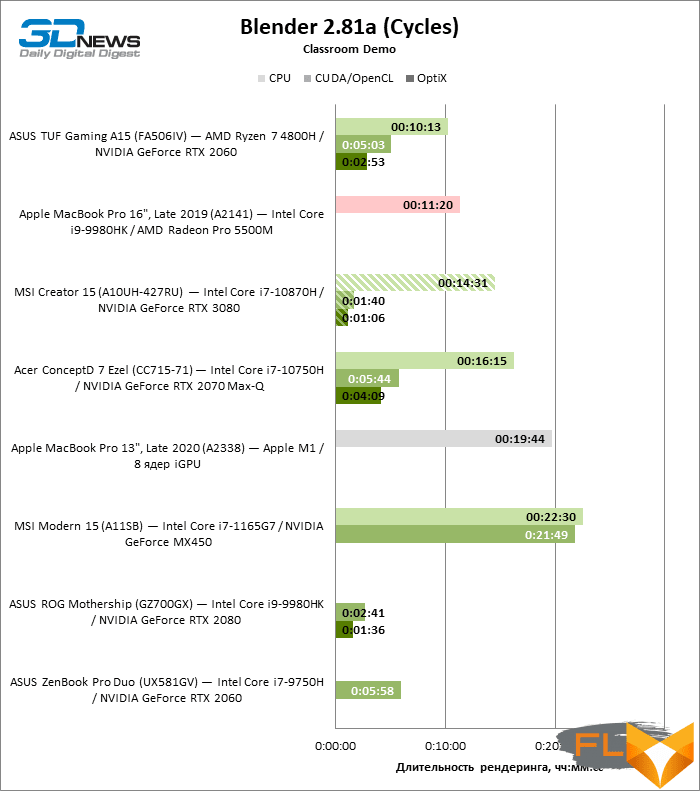


MSI introduced the Creator 15 series notebooks last year, bringing the company’s expertise in professional visualization hardware from the large-format Creator 17 laptops to smaller and lighter 15-inch laptops. And now that NVIDIA Ampere-based graphics accelerators are available not only as desktop and server add-on boards, but also as mobile GPUs, Creator 15-branded devices have undergone a major performance upgrade. We have already noted more than once that in products aimed at a professional audience, MSI knows how to squeeze the maximum performance out of laptop components, and we expect the same from the updated Creator 15.

We have to examine the flagship model of the series with an octa-core CPU, GeForce RTX 3080 graphics, a generous amount of all types of memory and an ultra-high resolution display.
⇡#Specifications, prices
The MSI Creator 15 is based on the Intel Comet Lake processor platform, represented by the 10th generation Core models. Unlike the latest 10nm Tiger Lake CPUs that have already found their way into low-power compact laptops (as well as large-format budget models), Comet Lake silicon is manufactured using older 14nm technology, which affects its energy efficiency. In addition, Tiger Lake contains a lot of architectural innovations, thanks to which Intel chips are now successfully competing with AMD Ryzen 4000 series processors in a number of tasks. Comet Lake processors lack these advantages, but Intel still has six- and eight-core mobile CPUs only within this family. . As a result, the choice for packaging laptops focused on demanding work applications falls between Comet Lake and AMD products. MSI in this case preferred Intel, namely the Core i7-10870H chip. This is the second highest position among the eight-core Core i7 of the 10th generation, it is designed for power consumption of 45W, and, as measurements will show, the laptop completely exhausts the regular reserve of CPU power.
By the way, the choice in favor of the Intel platform means that the laptop manufacturer can use the Thunderbolt interface, which AMD-based devices do not have. MSI Creator 15 is limited to the 3rd generation of the standard, but it must be said that Thunderbolt 4 (which is supported in Tiger Lake processors) has exactly the same bandwidth.
At the same time, although MSI was forced to use not the most progressive silicon as a central processor, in the updated Creator 15 catalog it is complemented by the latest NVIDIA GeForce 30 series video adapters – up to the flagship RTX 3080. It is this accelerator that is used in the instance of the laptop that we received for testing. Of course, the laptop version of the RTX 3080 is completely different from the desktop video card: it is built on a chip of the second tier of the Ampere architecture (GA104) instead of the older GA102. But whatever one may say, more productive GPUs in mobile performance simply do not exist yet. Part of the improvement that Ampere architecture has over Turing chips is focused on work applications rather than gaming, and this is the main scope of MSI Creator 15. Also, unlike GA104-based desktop graphics cards, which are content with 8 GB VRAM , the mobile RTX 3080 in this case is equipped with 16 GB of GDDR6.
As for other types of memory, the laptop comes in a configuration with 32 GB of dual-channel RAM and a single SSD of 1 or 2 TB.
Finally, the MSI Creator 15 specifications offer a choice between a Full-HD screen and a 4K sensor, which boasts factory calibration and Adobe RGB color gamut in addition to high resolution.
| Manufacturer | MSI |
|---|---|
| Model | Creator 15 |
| Display | 15.6”, 1920 × 1080 (60Hz), IPS; 15.6”, 3840×2160 (60Hz), IPS |
| CPU | Intel Core i7-10870H (8/16 cores/threads, 2.2-5.0 GHz) |
| RAM | DDR4 SDRAM, 3200 MT/s, 32 GB (two channels) |
| GPU | NVIDIA GeForce RTX 3060 (6GB GDDR6); NVIDIA GeForce RTX 3070 (8 GB GDDR6); NVIDIA GeForce RTX 3080 (16GB GDDR6) |
| Accumulator | SSD (PCIe 3.0 x4) 1024/2048 GB |
| External I/O headers | 1 × Thunderbolt 3; 1 x USB 3.2 Gen 2 Type-C; 3 × USB 3.2 Gen 1 Type-A; 1 × HDMI; 1 × TRS 3,5 мм |
| Сеть | 1 × Ethernet (1 Гбит/с); IEEE 802.11ax + Bluetooth 5.2 |
| Battery capacity, W⋅h | 99 |
| Weight, kg | 2,1 |
| Overall dimensions (L × H × D), mm | 358 × 248 × 19.8 |
| Retail price | Reviewed Configuration (GeForce RTX 3080, 2TB SSD, 4K Screen): Starting at $3,900 |
Naturally, a laptop with similar characteristics cannot be cheap, especially since this is not a gaming machine, but a mobile workstation. In retail, the older version of the Creator 15 with the GeForce RTX 3080 and 4K matrix is sold for $3,900 or more. However, when you take into account how expensive discrete graphics cards are these days, powerful laptops are looking more and more attractive as an alternative to a desktop PC. Especially if the quality of the screen and controls is on top, but we will make sure of this now.
⇡#Look and Ergonomics
Before us is a relatively thin and light machine, if we take into account the extremely powerful stuffing of the top models of the series. The body height is slightly less than 2 cm, and the laptop weighs 2.1 kg. The chassis of the Creator 15 is assembled from metal panels – as in most modern laptops, they are quite thin, but thanks to the dense internal layout and massive cooling system, which is a kind of stiffening rib, the device feels solidly knocked down (although pushing the working surface in the keyboard area is all – still possible).
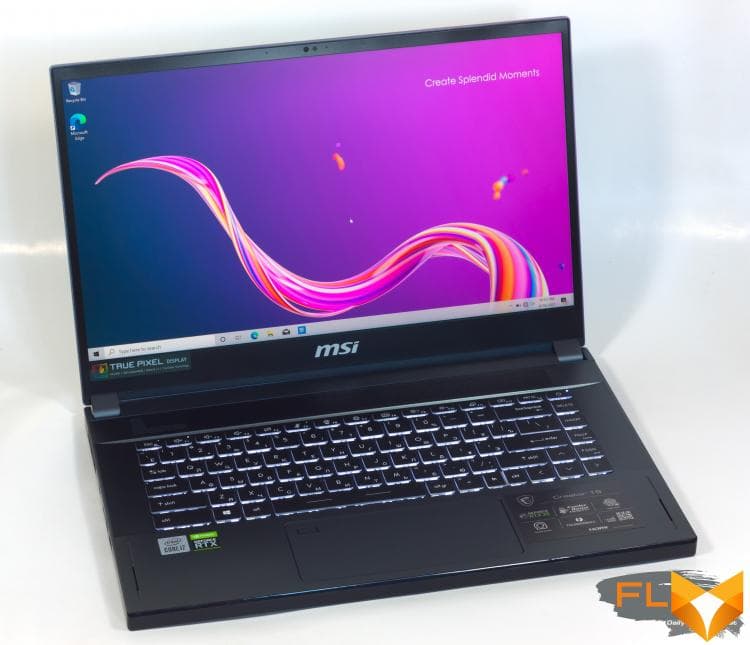
The screen cover is easy to lift with one hand, and it leans back up to 180°. This is done in order to assemble laptops with a sensitive screen in the same case. But in this case, the panel is not touch-sensitive and, as a result, not laminated – good news for those who periodically work in the sun. The 4K sensor that some versions of the MSI Creator 15 come with has a decent margin of brightness, but the matte finish solves the glare issue better than any kind of sputtering over smooth glass. Small by the standards of 15-inch laptops, the dimensions of the Creator 15 case in length and width are dictated by narrow frames around the matrix. A wide indent had to be made only at the bottom to increase the area of the touchpad, which is always lacking in 16:9 screen proportions.
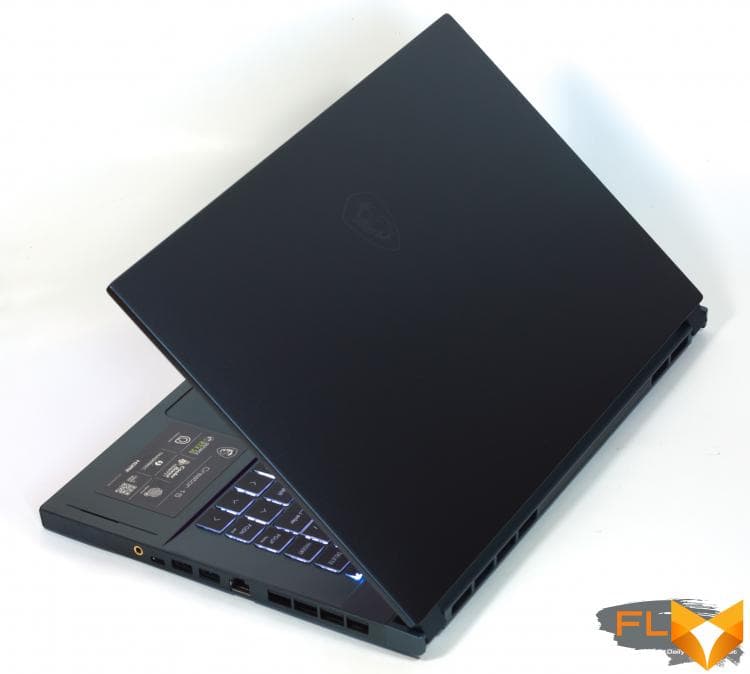
As we have already noticed, the MSI Creator 15 has a rather rigid design compared to most modern laptops, and this can be felt when typing on the keyboard. But to the keyboard itself, we had a few complaints. The beveled edges of the niche in which it is located have reduced the useful area of the working surface, and as a result, the width of some keys had to be sacrificed: “~” and, which is especially inconvenient, the right Ctrl. But there was a place for a number of full-size Delete, Insert, PgUp and PgDn keys, without which many users cannot imagine a computer keyboard. In addition, MSI still needs to work on the key mechanism, which seems to be used in a wide range of devices from this manufacturer with minimal changes. The rigid base instantly added a hundred points of comfort to the MSI Creator 15 keyboard, but the cones under the keys are still soft, with a lubricated actuation moment, and they return the covers to the neutral position relatively slowly.

The surface of the MSI Creator 15 touchpad is glass – a sign of a thoroughbred device, but the mechanics of the manipulator has its own flaw: the panel is not fully pressed against the switches laid under it, and as a result, a click is always heard with a light blow (which duplicates the left click). There is a cutout for the biometric sensor in the corner of the touchpad. The latter is not a continuation of the working surface of the touchpad, but it does not matter, the touchpad area is enough.
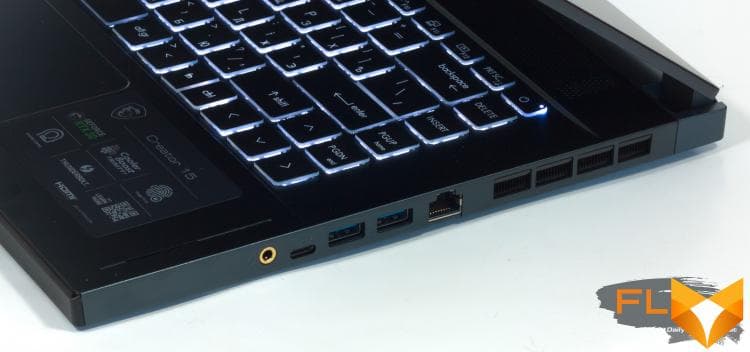
The eternal misfortune of ultrabooks is the lack of ports for cable peripherals, but the larger form factor of the Creator 15 and the uniform height of the case created space in order to bring out a lot of connectors on the sides: two USB Type-C, one of which works in Thunderbolt 3 mode, three USB Type-A, as well as a full-size HDMI and a wired Ethernet socket. Of course, there is also a mini-jack for an audio headset, but, alas, there is no memory card reader.
With such power of the main components, as in the older modifications of the Creator 15, there can be no question of powering the laptop through Thunderbolt. This standard is designed for a maximum of 100 watts of power, and the TDP / TBP rating of the CPU and GPU here is 45 and 115 watts. As a result, to work on the road, you will have to carry along with a laptop a weighty – almost 600 grams – power supply unit with a nominal value of 230 watts.
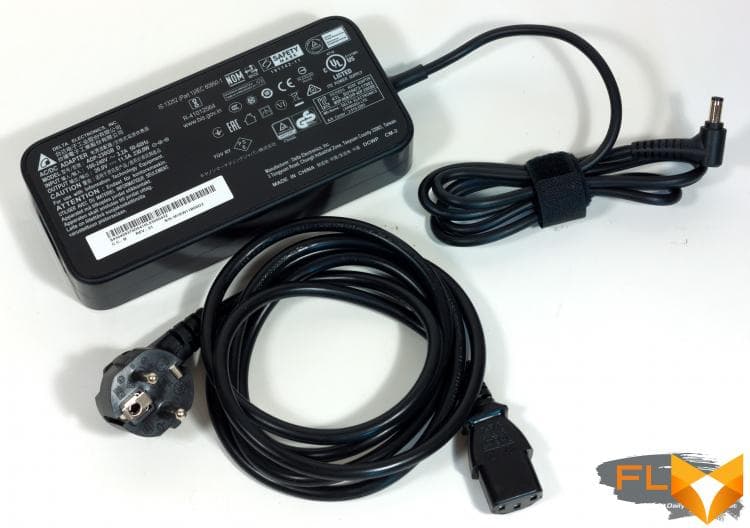
Internal design and upgrade options
The components of MSI Creator 15 are served by an impressive cooling system, which contains not one or two, but as many as three fans. Two of them blow over the GPU heat sink, and the third one blows over the CPU heat sink. In this case, the circuits of the central and graphics processors connect two common heat pipes. The base of the cooler covers not only the GPU itself, but also the memory, as well as the VRM of the video adapter.
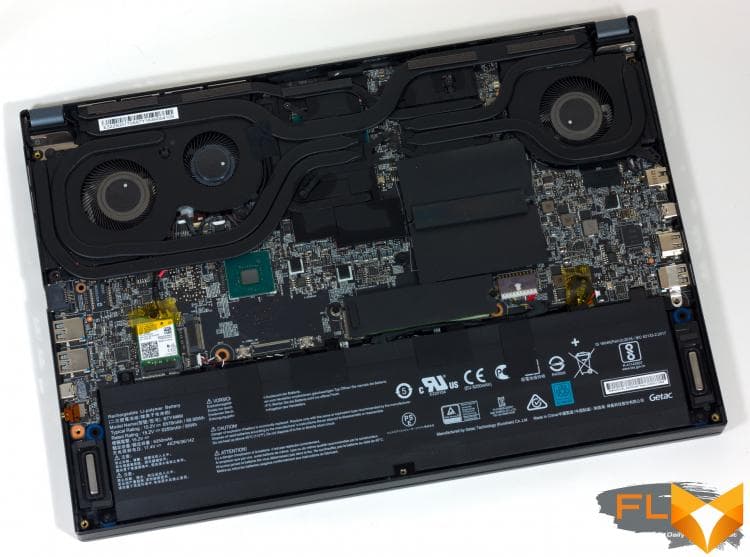
The cooler is designed in such a way that cold air enters through the grid of holes in the bottom panel of the chassis, and the heated air leaves the case in three directions: behind and on the sides.
The laptop allows you to replace the SSD and, unlike many more compact machines, RAM modules.

⇡#Test Methodology
| Synthetic tests | |
|---|---|
| Application | Settings |
| 3DMark Time Spy | — |
| Geekbench 4 | — |
| CINEBENCH R20 | — |
| GFXBench 5 (Aztec Ruins — Normal Tier, High Tier) | Windows: Vulkan, macOS: Metal |
| fio 3.16 | Sequential Read/Write, Random Read/Write (Unbuffered I/O) |
| Work Applications | |||||
|---|---|---|---|---|---|
| Application | Benchmark | Settings | API | ||
| Intel Graphics | AMD Graphics | NVIDIA Graphics | |||
| Adobe Photoshop CC 2019 | PugetBench for Photoshop CC 0.8 (linked test structure) | Basic Benchmark | OpenGL + OpenCL + Metal (macOS) | OpenGL + OpenCL + Metal (macOS) | OpenGL + OpenCL |
| Adobe Photoshop Lightroom Classic CC 2020 | PugetBench for Lightroom Classic 0.8 (test structure at link) | — | DirectX 12 (Windows) | DirectX 12 (Windows) | DirectX 12 |
| Adobe Premiere Pro CC 2019 | PugetBench for Premiere Pro 0.8 (linked test structure) | Standard Benchmark | OpenCL (Windows)/Metal (macOS) | OpenCL (Windows)/Metal (macOS) | CUDA |
| Blackmagic Design DaVinci Resolve Studio 16 | Puget Systems DaVinci Resolve Studio Benchmark 0.61 (test structure by link) | 4K Benchmark | OpenCL (Windows)/Metal (macOS) | OpenCL (Windows)/Metal (macOS) | CUDA |
| Fusion | |||||
| Blender 2.81a | Class Room demo from Blender Foundation | Cycles renderer. Feature Set: Supported. Tile size: 32 × 32 (CPU) or 256 × 256 (GPU) | N/A (CPU rendering) | OpenCL (Windows)/CPU (macOS) | CUDA/OptX |
| AMD Nissan GTR Demo | Radeon ProRender | N/A | OpenCL (Windows)/Metal (macOS) | OpenCL | |
Display testing is performed using a Datacolor Spyder4 Elite colorimeter in ArgyllCMS and DisplayCAL 3 applications.
Notebook battery life is measured at a display brightness of 200 cd/m2in the following usage scenarios:
- web surfing: alternately opening and closing tabs of Computeruniverse.ru and Unsplash.com sites with an interval of 25 seconds in the Google Chrome browser (cache and cookies are disabled);
- Continuous playback of 4K HEVC (H.265) video.
⇡#Test participants
The following devices took part in testing:
| Screen | CPU | RAM | GPU | SSD | HDD | Battery | |||
|---|---|---|---|---|---|---|---|---|---|
| MSI Creator 15 (A10UH-427RU) | 15.6”, 3840 × 2160, IPS | Intel Core i7-10870H | 8/16 cores/threads, 2.2-5.0 GHz | DDR4 SDRAM, 3200 MT/s, 32 GB | NVIDIA GeForce RTX 3080 | 16GB GDDR6 | Samsung PM981 (PCIe 3.0 x4) 2048 GB | No | 99 Wh |
| Acer ConceptD 7 Ezel (CC715-71) | 15.6”, 3840 × 2160, IPS | Intel Core i7-10750H | 6/12 cores/threads, 2.6-5.0 GHz | DDR4 SDRAM, 2666 MT/s, 16 GB | NVIDIA GeForce RTX 2070 Max-Q | 8GB GDDR6 | RAID 0: 2 × Samsung PM981a (PCIe 3.0 x4) 512 GB | No | 84 Wh |
| Apple MacBook Pro 13″, Late 2020 (A2338) | 13.3”, 2560 × 1600, IPS | Apple M1 | 4+4 cores/threads, ≤3.2 GHz | LPDDR4X SDRAM, 4266 MT/s, 16 GB | 8 iGPU cores | System RAM | Apple AP2048Q (Apple Fabric) 2048 GB | No | 58.2 Wh |
| Apple MacBook Pro 13″, Late 2020 (A2338) | 13.3”, 2560 × 1600, IPS | Apple M1 | 4+4 cores/threads, ≤3.2 GHz | LPDDR4X SDRAM, 4266 MT/s, 16 GB | 8 iGPU cores | System RAM | Apple AP2048Q (Apple Fabric) 2048 GB | No | 58.2 Wh |
| Apple MacBook Pro 16″, Late 2019 (A2141) | 16”, 3072 × 1920, IPS | Intel Core i9-9980HK | 8/16 cores/threads, 2.4-5.0 GHz | DDR4 SDRAM, 2666 MT/s, 16 GB | AMD Radeon Pro 5500M | 4GB GDDR6 | Apple AP1024N (PCIe 3.0 x4) 1024 GB | No | 100 Wh |
| ASUS ROG Mothership (GZ700GX) | 17,3”, 3840 × 2160, IPS | Intel Core i9-9980HK | 8/16 cores/threads, 2.4-5.0 GHz | DDR4 SDRAM, 2666 MT/s, 64 GB | NVIDIA GeForce RTX 2080 | 8GB GDDR6 | RAID 0: 2 × Intel SSD 760p (PCIe 3.0 x4) 512GB + Samsung PM981 (PCIe 3.0 x4) 512GB | No | 90 Wh |
| ASUS TUF Gaming A15 (FA506IV) | 15.6”, 1920 × 1080, IPS | AMD Ryzen 7 4800H | 8/16 cores/threads, 2.9-4.2 GHz | DDR4 SDRAM, 3200 MT/s, 32 GB | NVIDIA GeForce RTX 2060 | 6GB GDDR6 | Micron 2200 (PCIe 3.0 x4) 1024 GB | No | 90 Wh |
| MSI Modern 15 (A11SB) | 15.6”, 1920 × 1080, IPS | Intel Core i7-1165G7 | 4/8 cores/threads, 2.8-4.7 GHz | DDR4 SDRAM, 3200 MT/s, 16 GB | NVIDIA GeForce MX450 | 2GB GDDR5 | Kingston OM8PCP3512F-AI1 (PCIe 3.0 x2) 512GB | No | 52 Wh |
⇡#Screen Quality
The test copy of MSI Creator 15 uses an excellent matrix with 4K resolution and extended color gamut. With such a pixel density, one cannot count on a high level of brightness, and yet the Creator 15 screen reaches an impressive brightness by the standards of laptop matrices of 360 cd/m2. In terms of contrast, it is also inferior to the best samples in dimensions of 15-16 inches, but 826:1 is an excellent result compared to what is found in mainstream laptop screens.
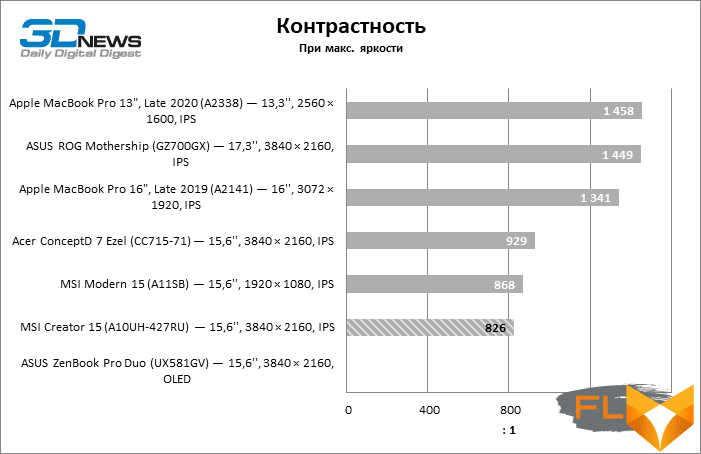
The screen’s native color range more than covers the Adobe RGB space. Although the Creator 15 is positioned as a machine for professional visualization tasks, the system does not have an ICC profile that describes the parameters of the matrix. But they are hardwired into the MSI True Color utility, with which you can adapt the image to various content in applications that lack their own color correction system. In particular, the program contains profiles tailored to the Adobe RGB or sRGB standard. The latter is especially important, since without the limitation of color gamut at the driver level, most Windows software and the OS user interface itself display an oversaturated image on Wide Gamut screens. Here, the coordinates of the base colors correspond almost perfectly to the sRGB parameters. But the Adobe RGB setting, oddly enough, no longer uses the entire color range available to the matrix, within the same standard. But this is quite forgivable for a screen without individual profiling, which professional users will need to do anyway.
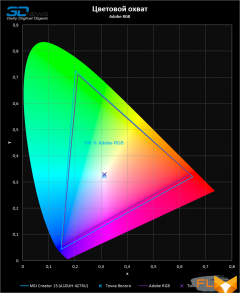 Native gamut |
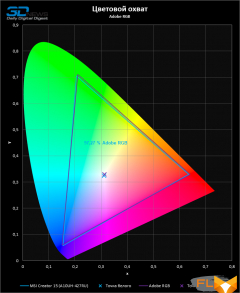 Adobe RGB |
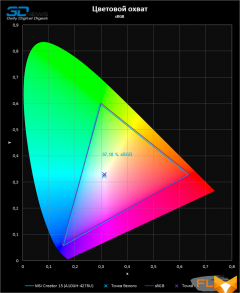 sRGB |
In both modes – sRGB and Adobe RGB – the color temperature of the matrix is set exactly at 6500 K.
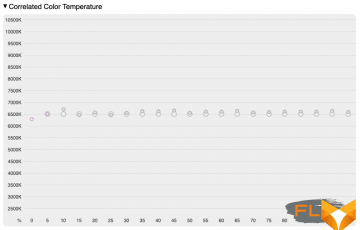 Adobe RGB |
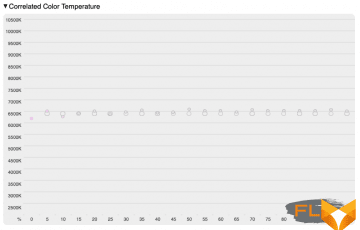 sRGB |
When using both presets, the gamma correction curve follows the sRGB standard, which contains an almost linear region near zero, rather than the 2.2 power function provided by Adobe RGB.
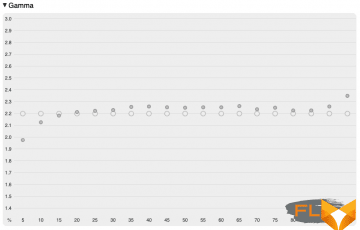 Adobe RGB |
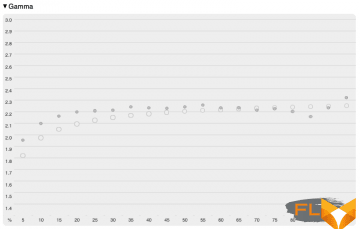 sRGB |
The brightness of the base colors is perfectly matched across the entire scale, with the exception of dark shades from 5 to 15% of maximum brightness (measured at 150 cd/m2).
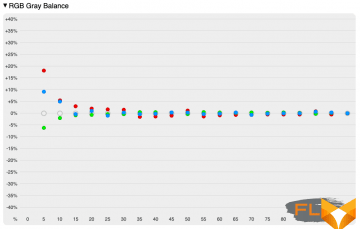 Adobe RGB |
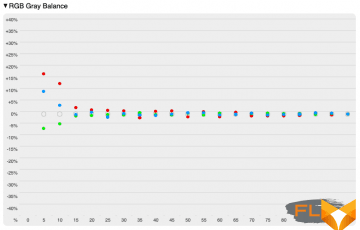 sRGB |
As a result of pre-calibration and well-tuned sRGB and Adobe RGB presets, the MSI Creator 15’s screen shows excellent color reproduction of the respective content. In both modes, the average value of Delta E 2000 does not exceed one, corrected for white point, which still does not match perfectly with the D65 reference position.
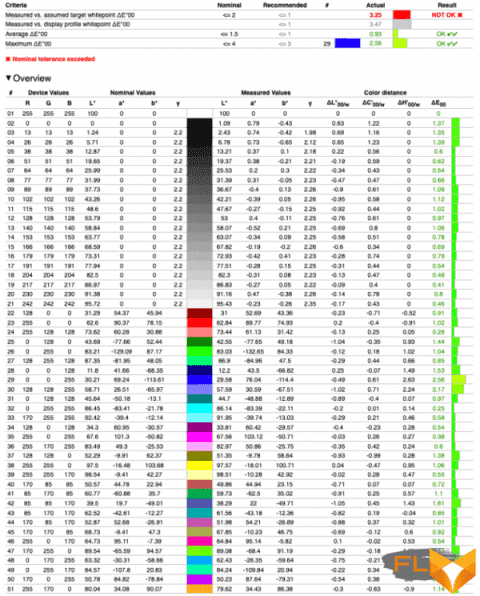
Adobe RGB
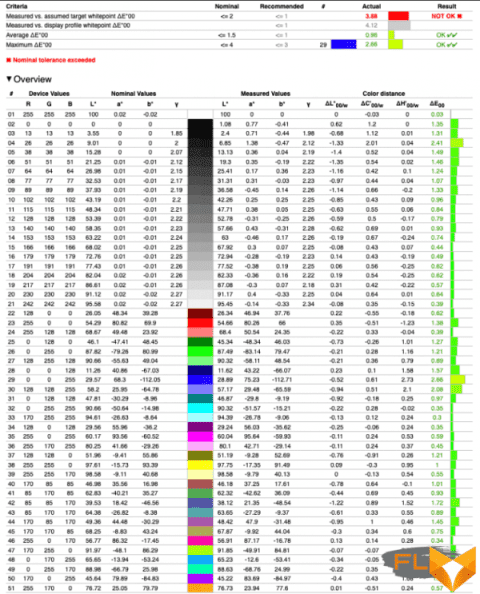
sRGB
⇡#Clock speeds, temperature and noise level
MSI Creator 15 uses a high-performance Intel H-series CPU, which has a correspondingly high power consumption. The control software pre-installed on the laptop allows you to adjust the power of the components and, accordingly, the operation of the cooling system. So, in the maximum performance mode, the chip almost entirely uses the nominal power reserve of 45 W and maintains a clock speed of about 2.7 GHz with a full load of eight cores. In balanced mode, the power drops to 40 watts, but the clock frequency drops slightly – to 2.65 GHz. And finally, in quiet mode, the specified parameters are 30 W and 2.2 GHz, respectively.
The mobile version of discrete graphics GeForce RTX 3080 also allows you to vary the power consumption by software. With a stock GPU TBP of 115W, the laptop delivers up to 97W of power to the GPU, and clock speeds hover around 1.15GHz under load. Economical settings reduce power in steps to 85 and 55W, while stable clock speeds go up to 991MHz and all the way down to an extremely low level of 386MHz.
With simultaneous loading of the CPU and GPU, priority, as is usually the case in mobile PCs, is given to discrete graphics. As a result, in maximum power mode, the CPU has to drop the average clock speed to 2.1 GHz, and in economy modes to 1.9 and 1.26 GHz, while the operating parameters of the GPU change slightly compared to what occurs in isolated graphics tests.
| Load Clock | ||||||||
|---|---|---|---|---|---|---|---|---|
| Cinebench R20 (Max Thread #) | LuxMark 3.1 | Cinebench R20 (Max Thread #) + LuxMark 3.1 | ||||||
| CPU clock speed, MHz | GPU clock speed, MHz | CPU clock speed, MHz | GPU clock speed, MHz | |||||
| Medium | Max | Medium | Max | Medium | Max | Medium | Max | |
| MSI Creator 15 (A10UH-427RU) – Intel Core i7-10870H / NVIDIA GeForce RTX 3080 – High Performance | 2712 | 2881 | 1153 | 1230 | 2146 | 3293 | 1044 | 1245 |
| MSI Creator 15 (A10UH-427RU) – Intel Core i7-10870H / NVIDIA GeForce RTX 3080 – Balanced | 2649 | 3094 | 991 | 1125 | 1900 | 3006 | 979 | 1185 |
| MSI Creator 15 (A10UH-427RU) – Intel Core i7-10870H / NVIDIA GeForce RTX 3080 – Silent | 2243 | 2296 | 386 | 465 | 1260 | 2008 | 350 | 420 |
| CPU and GPU power | ||||||||
|---|---|---|---|---|---|---|---|---|
| Cinebench R20 (Max. # of threads) | LuxMark 3.1 | Cinebench R20 (Max Thread #) + LuxMark 3.1 | ||||||
| CPU power consumption, W | GPU power consumption (SoC as a whole for iGPU), W | CPU power consumption, W | GPU power consumption (SoC total for iGPU, W | |||||
| Medium | Max | Medium | Max | Medium | Max | Medium | Max | |
| MSI Creator 15 (A10UH-427RU) – Intel Core i7-10870H / NVIDIA GeForce RTX 3080 – High Performance | 43 | 44 | 97 | 97 | 42 | 44 | 88 | 88 |
| MSI Creator 15 (A10UH-427RU) – Intel Core i7-10870H / NVIDIA GeForce RTX 3080 – Balanced | 40 | 41 | 82 | 82 | 37 | 39 | 83 | 83 |
| MSI Creator 15 (A10UH-427RU) – Intel Core i7-10870H / NVIDIA GeForce RTX 3080 – Silent | 30 | 30 | 55 | 55 | 23 | 23 | 57 | 57 |
Note The measurement is performed after the device has warmed up and all parameters have stabilized.
The MSI Creator 15 is a fairly compact machine for its impressive specs. The cooling system keeps the temperature of the components within formally acceptable limits, and yet, at any power settings, the CPU warms up to no less than 92 °C under maximum load, and up to 98 °C under conditions of combined load on the central processor and graphics. We recorded the maximum GPU temperature at 87 ° C, which is the norm for discrete accelerators in both desktop and mobile versions.
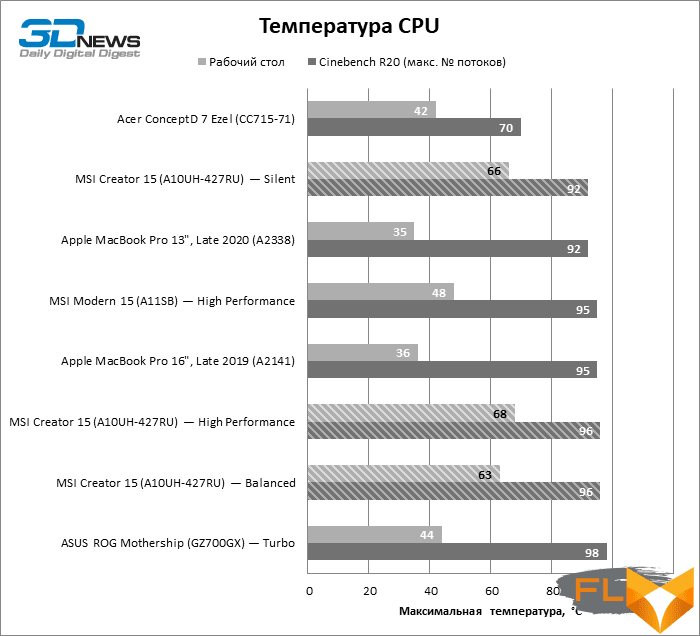
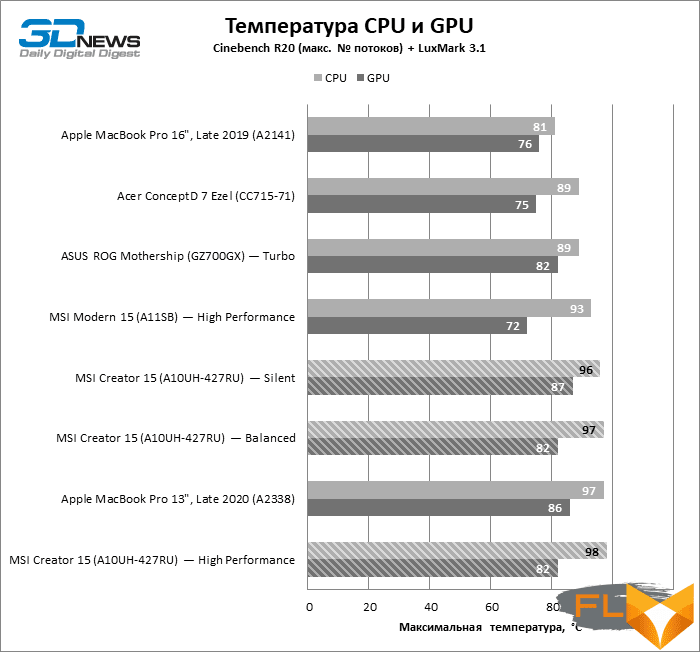
In balanced mode and maximum performance mode, MSI Creator 15 not only gets very hot, but also makes a lot of noise. In fact, among the mobile workstations that have been tested by 3DNews in recent years, this is the noisiest model, and the difference between the Balanced and High Performance presets exists only with an isolated load on the CPU or GPU, and the full load of both components is accompanied by equally loud noise. Also note that the rotation of the Creator 15’s fans is audible even when the computer is idle, although many laptops in this category run inaudibly when idle. Alas, high noise levels are the inevitable price to pay for packing extremely powerful and high-performance components into the relatively thin and light Creator 15 chassis.
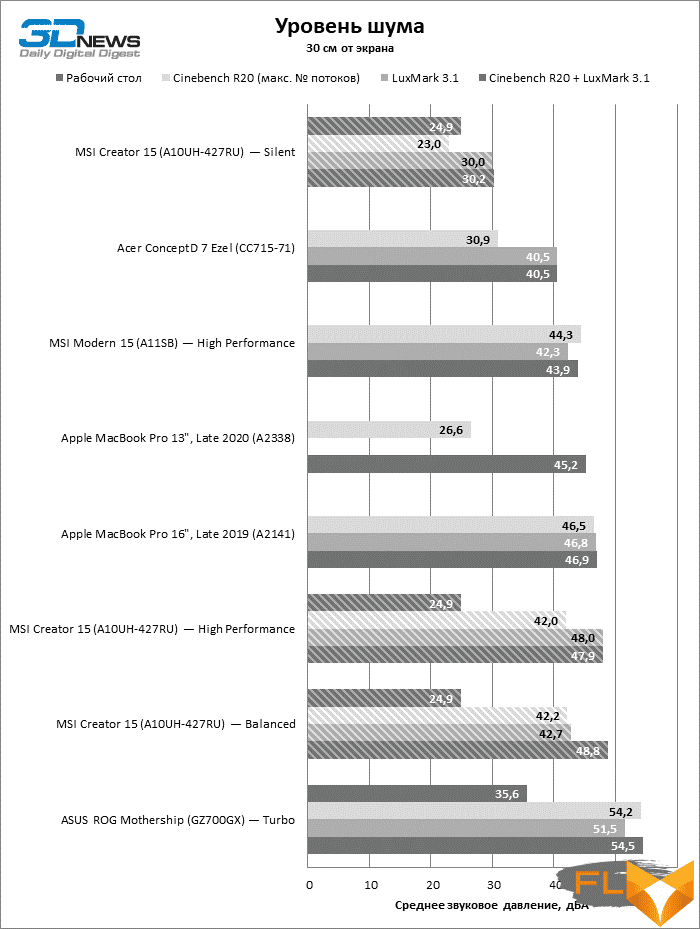
⇡#Synthetic benchmarks
The cooling system of the MSI Creator 15 does not provide the CPU with the same high clock speeds as in larger (or even hotter) laptops, also equipped with six- and eight-core Intel CPUs. As a result, according to isolated processor benchmarks, the MSI laptop ranked in the middle of the charts. In addition, the Core i7-10870H chip cannot compete on equal terms with AMD’s eight-core Ryzen 4000 series. Nevertheless, the Creator 15 easily outperforms laptops based on low-wattage Intel chips and even MacBooks on Apple M1 in x86 emulation mode in terms of CPU speed.
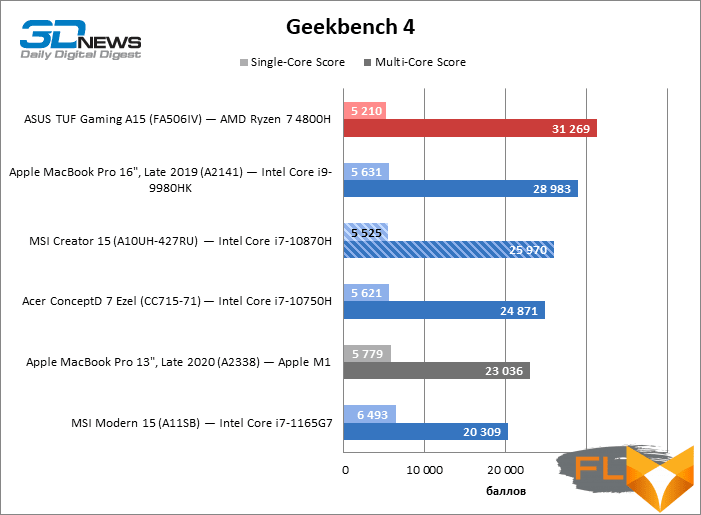
There aren’t many professional laptops with powerful discrete graphics in our test base that can be compared to the MSI Creator 15. But if we compare the mobile version of the GeForce RTX 3080 with previous generation NVIDIA accelerators such as the GeForce RTX 2060 and RTX 2070 Max- Q, the new silicon delivers tremendous performance gains. According to 3DMark results, the mobile RTX 3080 comes close to the RTX 2080 in the ASUS ROG Mothership desktop, which is an excellent result, because ASUS overclocked the GPU to desktop graphics card clock speeds, and MSI’s RTX 3080 is quite a typical laptop option.
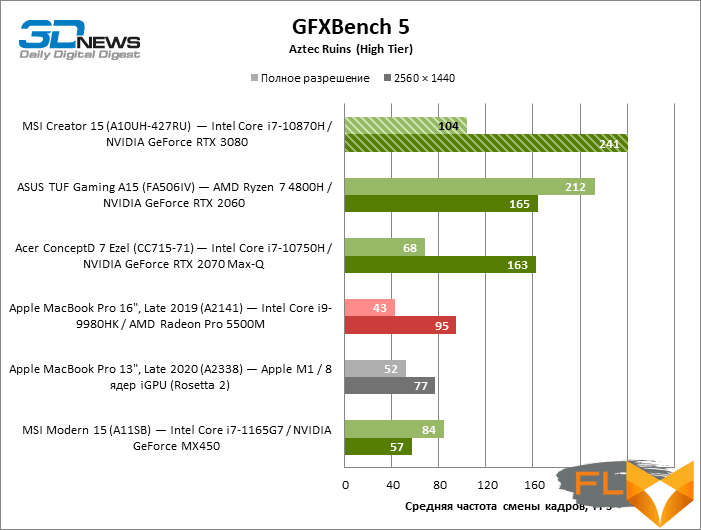
⇡#Performance in production applications
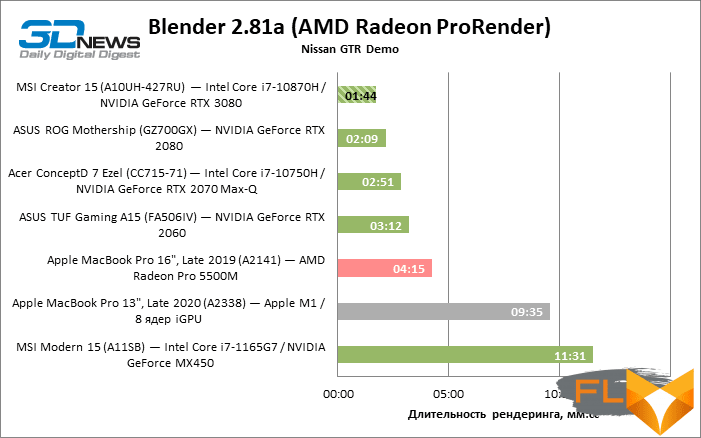
The Adobe Lightroom benchmark is sensitive to single-threaded CPU performance and, accordingly, its clock speeds. As a result, two additional x86 cores do not give the MSI Creator 15 an advantage over powerful six-core laptops. And the highest performance in Lightroom today is provided by Intel’s Tiger Lake chips. Be that as it may, there is no task in Lightroom that an MSI Creator 15 laptop cannot handle. The differences between the compared devices in this test do not have much practical significance.
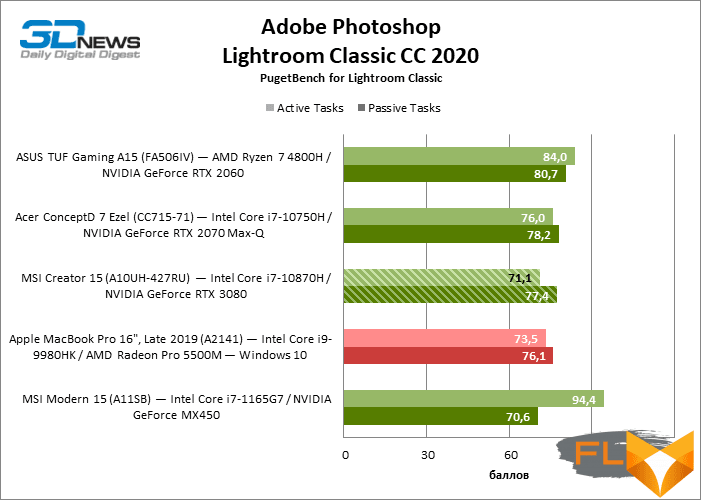
Note Scores are calculated as a percentage of Intel Reference Workstation performance Core i9-9900K, NVIDIA GeForce RTX 2080, 64GB RAM.
The last conclusion is also valid for the next benchmark. Any powerful laptop with a six- or eight-core CPU has enough processing power to run Adobe Photoshop. Nevertheless, eight cores and top-end discrete graphics bring the MSI Creator 15 to the lead here.
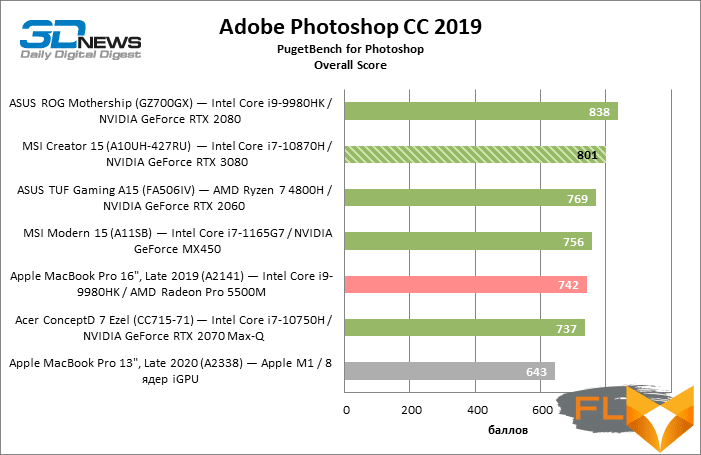
Note Scores are calculated as a percentage of Intel Reference Workstation performance Core i9-9900K, NVIDIA GeForce RTX 2080 and 64GB RAM x 10.
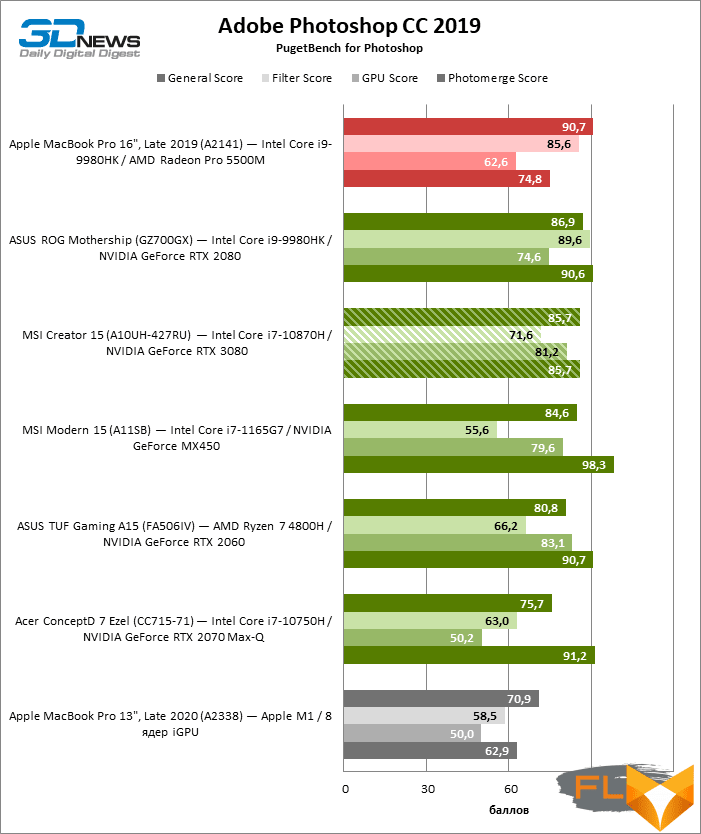
Note Scores are calculated as a percentage of Intel Reference Workstation performance Core i9-9900K, NVIDIA GeForce RTX 2080, 64GB RAM.
Integral scores in the Adobe Premiere Pro benchmark put the MSI Creator 15 in the middle of the chart with other laptops with six- and eight-core CPUs, not far from the MacBook Pro with the Apple M1 SoC. However, it’s worth looking into the individual test data to find out the strengths and weaknesses of the MSI laptop when working with Premiere Pro.
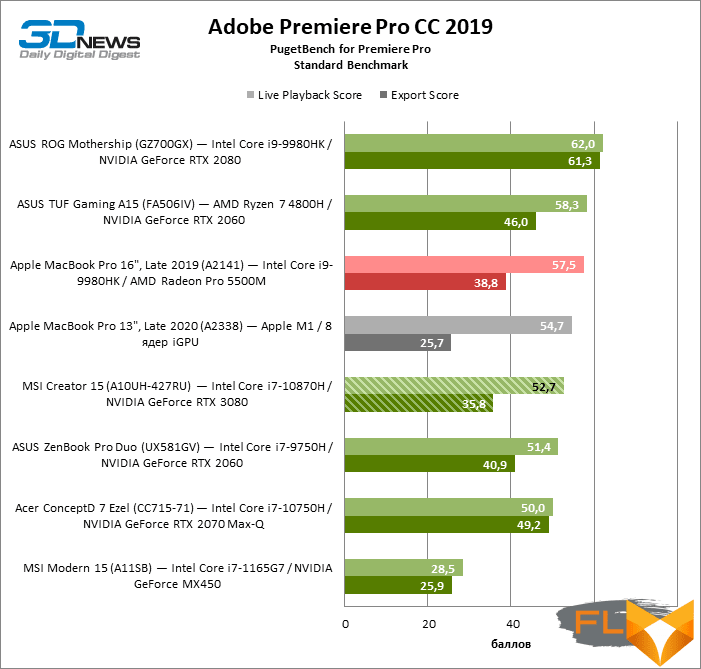
Note Scores are calculated as a percentage of the frame rate of the source or target format (for example, playing a video at full frame rate is worth 100 points). Unlike playback, when rendering video, the frame rate can exceed the target, which means that the score will be higher than 100.
In terms of frame rate during playback of a 4K project with complex effects based on the CPU, MSI Creator 15 is inferior to AMD eight-core models, but it has one of the best results in the Intel camp. When using a proxy with a resolution of 1/2 of the original, the performance is quite enough to play back sources shot at 25 FPS. But the rendering of such a project MSI Creator 15 is slower – compared to both “red” laptops and computers on eight-core Intel chips that operate at higher clock speeds.
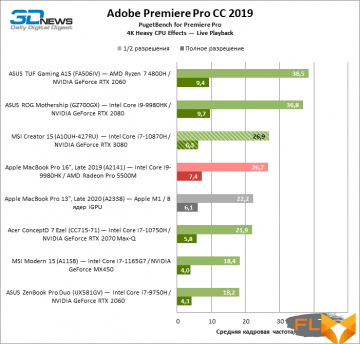 |
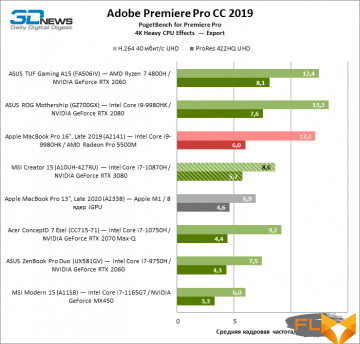 |
While the Intel mobile platform currently lacks leading multi-threaded performance, it more than makes up for it with a powerful discrete GPU like the GeForce RTX 3080. A laptop based on this platform can play complex 4K projects in full resolution at 30 FPS and deliver 60 FPS at resolution 1/2. Accordingly, the rendering of the project takes place in the shortest possible time.
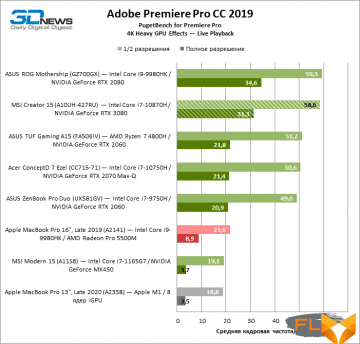 |
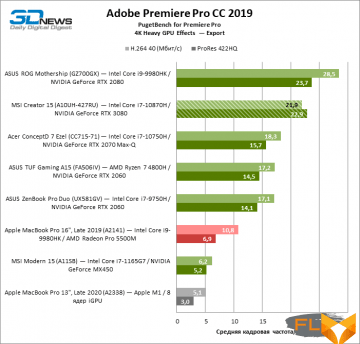 |
In terms of overall multi-codec performance in DaVinci Resolve, MSI Creator 15 scores predictably well thanks to powerful discrete graphics, as can be seen in some of the complex effects tests using the ProRes 422 codec.

Note Scores are calculated as a percentage of Intel Reference Workstation performance Core i9-9900K and NVIDIA TITAN RTX.
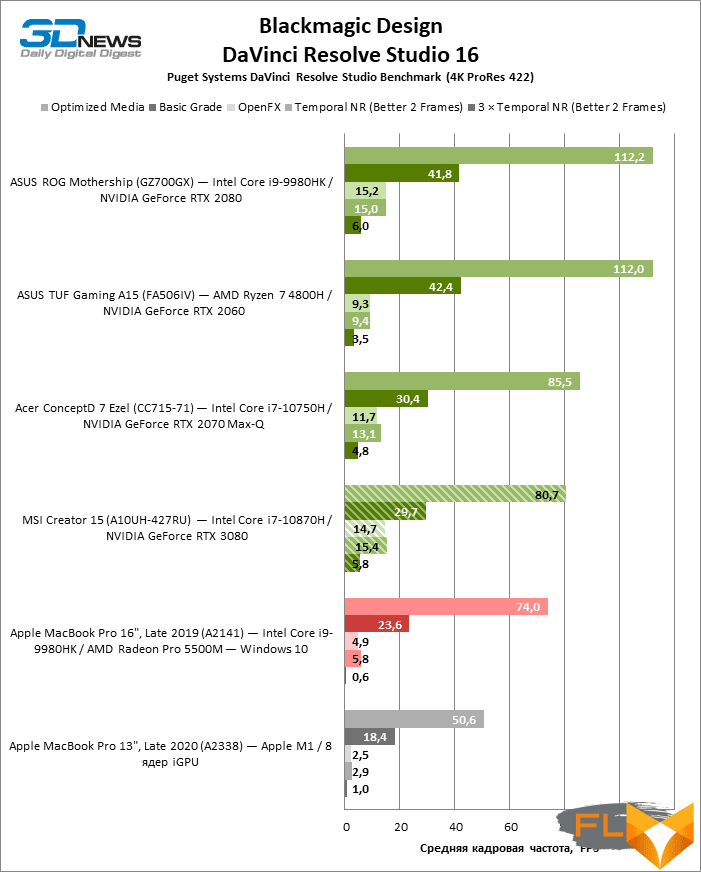
In contrast, the Fusion tools in DaVinci Resolve are weakly GPU dependent. MSI Creator 15 in the corresponding benchmark is inferior to laptops on the eight-core Ryzen 4000 (and in some operations even the MacBook Pro on the Apple M1 chip) and does not have practically significant advantages over devices with six Intel cores.
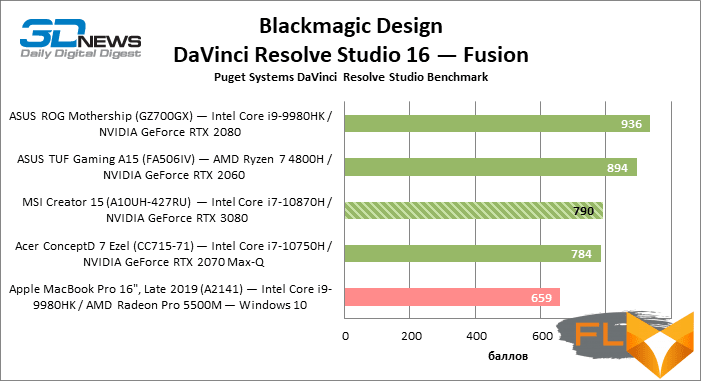
Note Scores are calculated as a percentage of the performance of a reference workstation based on Intel Core i9-9900K and NVIDIA TITAN RTX multiplied by 10.
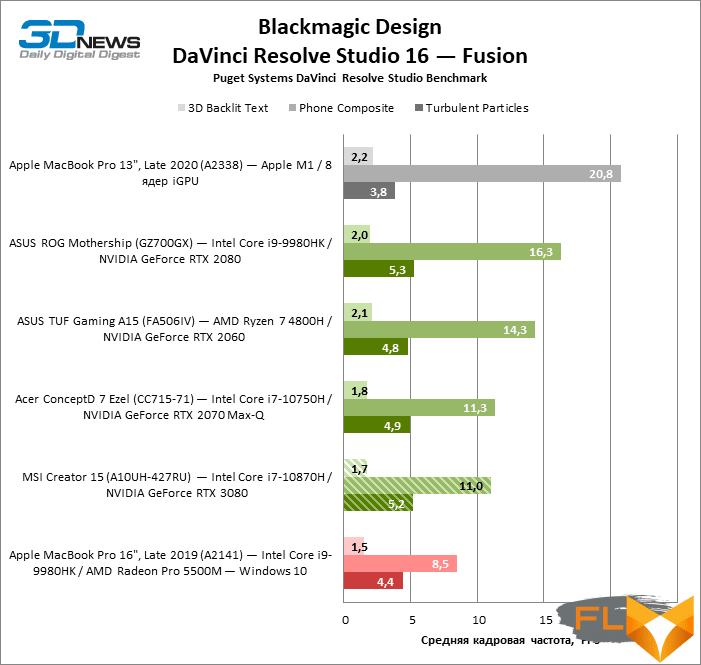
⇡#SSD performance
The Samsung PM981 solid-state drive in the MSI Creator 15 demonstrates performance that is quite typical for this widespread model. Among SSDs, which are also often found in mobile computers, it stands out for its excellent linear block read and random write speeds, as well as good linear write and random read performance. The CPU of the MSI Creator 15 is more than enough to guarantee the maximum number of requests per second that its controller can handle for a high performance SSD.
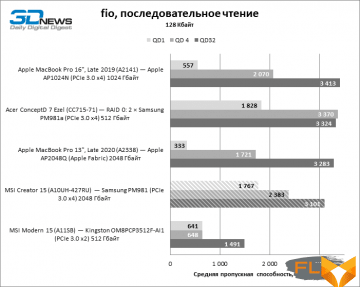 |
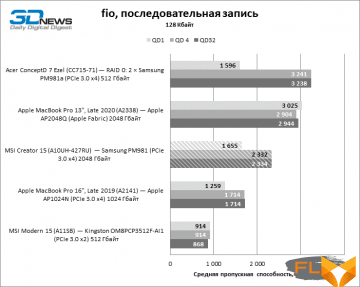 |
|
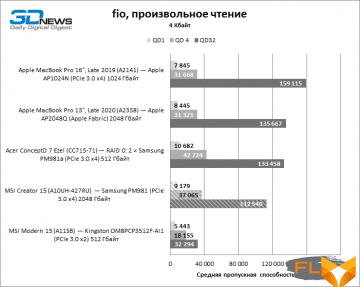 |
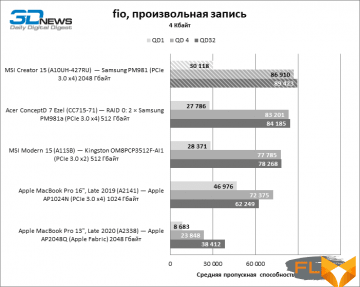 |
⇡#Battery Life
Most high-end laptops don’t offer long battery life. However, thanks to its solid battery capacity (99 Wh), the MSI laptop is characterized by high autonomy, adjusted for its extremely powerful components: the laptop withstood almost 6 hours of continuous web surfing on a single charge at a screen brightness of 200 cd/m2 sup> and more than 7 hours of video playback. True, such impressive results are possible only in the mode of the most severe restrictions on power consumption and clock speeds (Super Battery preset), and to work in any resource-intensive applications, the Creator 15 user will still have to look for an outlet.
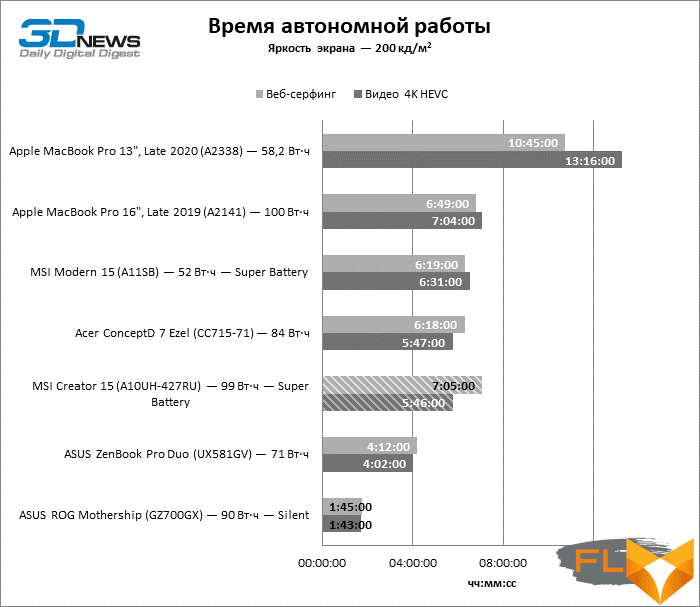
⇡#Conclusions
The MSI Creator 15 laptop has everything you need to solve the complex tasks of professional visualization: a powerful eight-core CPU, a large amount of RAM and storage. And the new NVIDIA GeForce 30 series video adapters not only significantly raised the bar for performance, but also, if we are talking about the flagship model, have 16 GB of VRAM, which is redundant for mobile gaming, but is in demand by working software.
However, the choice of main components is not the main thing that makes the updated Creator 15 series good. We can’t say anything about models with a Full HD screen – we haven’t met them yet – but MSI has chosen an excellent 4K wide color gamut sensor that provides accurate color reproduction out of the box and, most importantly, adjusts to sRGB content with one click without loss of image quality. When you know what screens are installed in most mobile PCs (including some devices that also claim to be professional), you can’t help but appreciate what MSI has done.
The Creator 15 is not without flaws of a different kind. First, as in other laptops from this company that we have studied earlier, the keyboard with a touchpad could be better (although compared to simpler models, progress is evident). And secondly, you can’t deceive physics, and a car with such a powerful filling in a rather thin chassis cannot help but make noise. Well, the price of a laptop is not that low. However, the MSI Creator 15 is not even the most expensive option among its kind if you need high performance, an excellent screen, and all this in a compact form factor.





